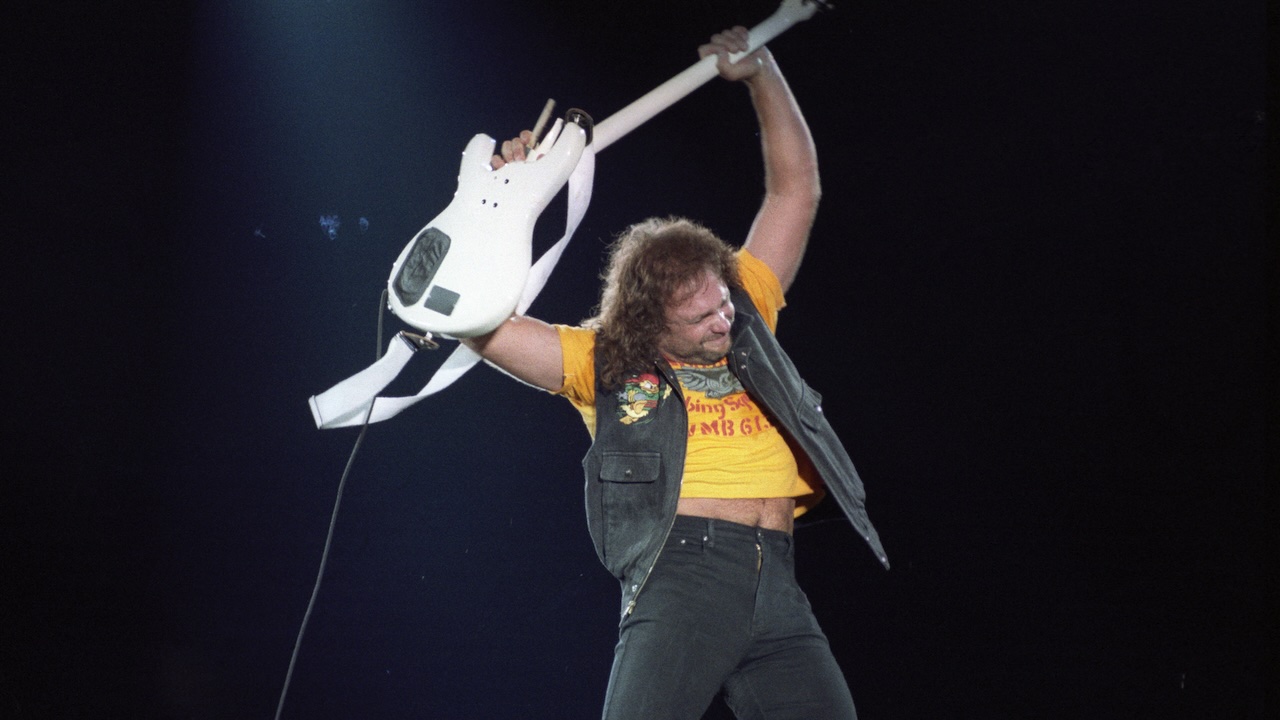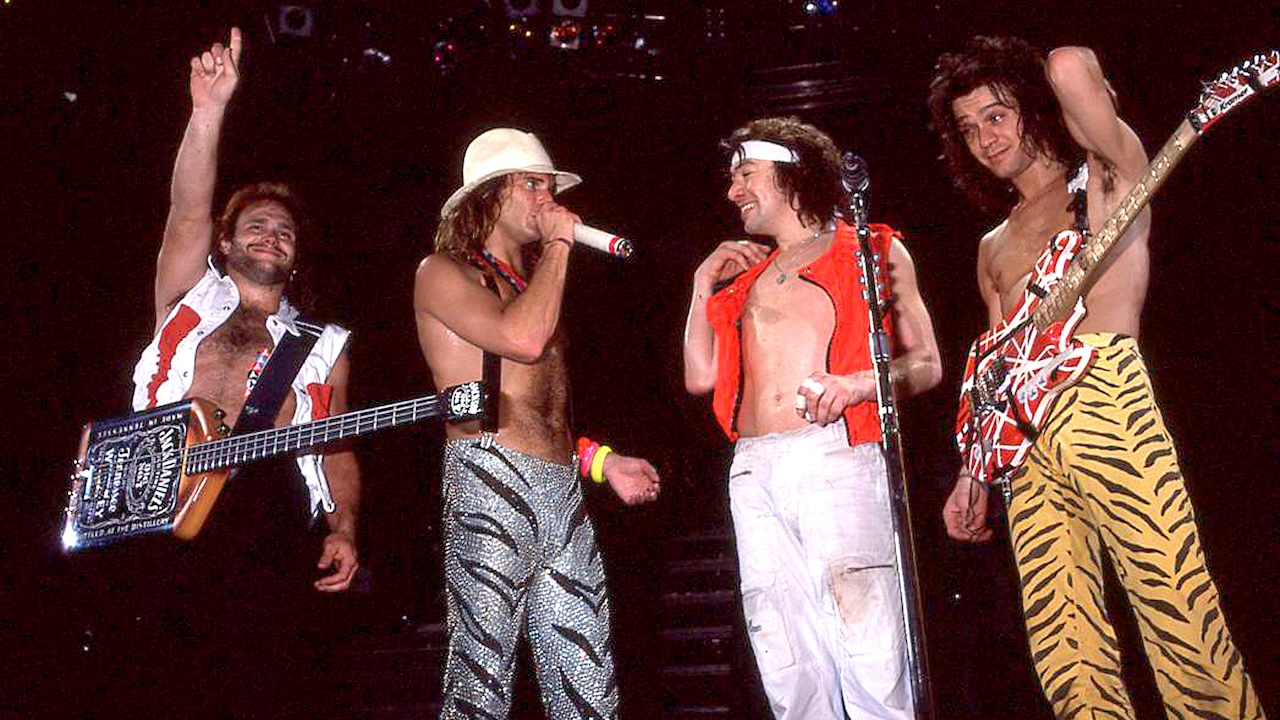“I would run across the stage and ‘break’ the bass over my head while our sound guy played samples of trees cracking”: Described as the 4-string equivalent of painting with a sledgehammer, Van Halen’s Ultra Bass was not your typical bass solo
Michael Anthony’s Yamaha BB2000 would get rebuilt after every show following his foundation-shaking solo spot

Fresno, California, 1992: “I'd like to introduce the fourth and fifth members of Van Halen,” announced singer Sammy Hagar. “Prepare yourself for a pint-sized, whiskey-drinkin', crazy mother, because he's about to take the loudest, wildest, and most unusual rock ’n’ roll bass solo you've ever heard. Here they are – Mr. Michael Anthony and Mr. Jack Daniels!”
After a swig from a half-empty bottle of Tennessee sippin’ whiskey, bassist Michael Anthony cruises into his solo. His trademark J.D. bottle-shaped bass guitar pours out mellow, delay-enhanced notes that rise to the rafters.
Moments later the serenity ends, as a brutal blow to the top of Old #7 sends a wave of flanged, fuzz-drenched riffs crashing into the gathering. But Anthony’s just getting warmed up.
Scurrying back and forth on the stage, he quotes a phrase from The Star-Spangled Banner, kicks a stranded beach ball off the stage-right riser, and makes a left-hand turn towards Mt. Ampeg – finding himself face-to-face with 16 SVT 8x10s. (That's 128 speakers!)
And then the crowd-killing finale: standing inches away from the towering wall of cabs, Anthony lashes out and beats them with his hands until they howl with feedback, engulfing him in ear-shattering squeals. The crowd roars its approval.
Welcome to Ultra Bass, a foundation-shaking exhibition described by one writer as “the 4-string equivalent of painting with a sledge-hammer.”
“I started doing the solo during our 1979 tour,” Anthony told Bass Player back in November 1995. “Some kid came up to me after a show one night and said, ‘The New Barbarians were here the other week, and Stanley Clarke played a great solo but man, your solo kicked ass all over that!’
All the latest guitar news, interviews, lessons, reviews, deals and more, direct to your inbox!
“I thought, ‘Is this the mentality of the people I'm playing for?!’ And I started to look at it as something more than the traditional, ‘Look how fast I can play’ thing.
“I've always loved dicking around with cheap MXR and Colorsound effects, so I tried to put together something that would throw everybody for a loop. One day I played through a fuzz, and the guys all said, ‘That's great!’”
Were you tempted to throw in a tapping part?
“No. The last thing I want someone to say is, ‘Wow, he's trying to be like his guitar player!’ I can do some of the tapping stuff, but in that band, why? Being that I was playing with the guy who invented it, I didn't see the need.”

You've also been known to throw your bass around.
“Yeah – I used to have a Yamaha BB2000 that would get rebuilt after every show. For the Monsters of Rock tour I got a guy to make me a bass with the mechanism from a shotgun that opens the barrels. I would run across the stage doing all these synthesized sounds, hit the lever behind the neck, and ‘break’ the bass over my head while our sound guy played samples of trees cracking!”
And the bass could just be snapped back together?
"Sure, but my tech had to run around the stage and find all the bridge saddles and hardware! The techs back then didn't appreciate what I did during my solo, because they'd have to get the bass working for the next show.”

How did the idea for the Jack Daniels bass come about?
“I used to drink quite a bit of Jack Daniels, and everyone would say to me, ‘You should have a bass that looks like a J.D. bottle!’ So I got together with a couple of guys on our crew, and we put together the first Jack Daniels bass. I had Charvel make the body and neck, and I added the tuners from another bass and got a Zeta piezo bridge. It was slapped together, but it didn't sound half-bad.
“The next thing you know, I had another one built by James Tyler in L.A. Originally, the J.D. bass was more of a novelty, but it was one of those things that caught on. All of a sudden, it became part of the show, part of my personality. [Editor's Note: The original J.D. bass is now on display at the Hard Rock Hotel in Las Vegas.]”
Jim Roberts was the founding editor of Bass Player and also served as the magazine’s
publisher and group publisher. He is the author of How The Fender Bass Changed The World
and American Basses: An Illustrated History & Player’s Guide, both published by Backbeat
Books/Hal Leonard.
You must confirm your public display name before commenting
Please logout and then login again, you will then be prompted to enter your display name.
